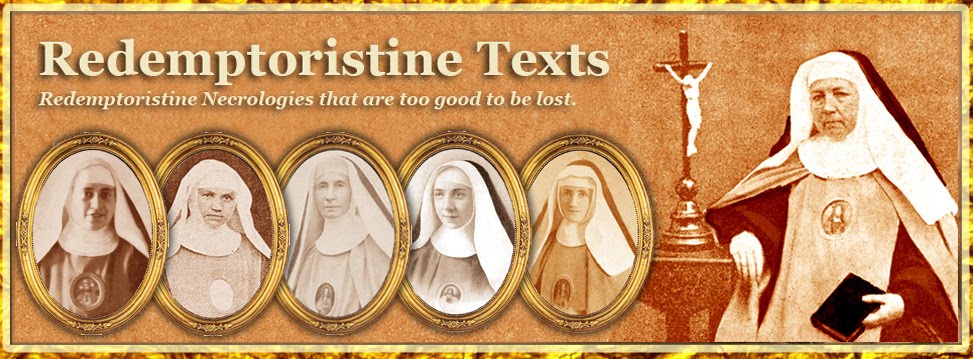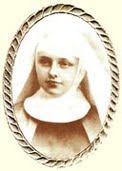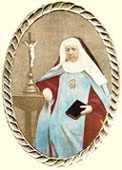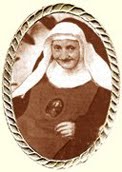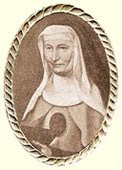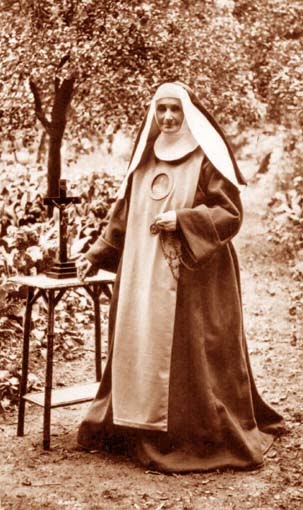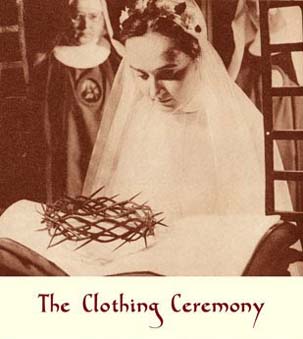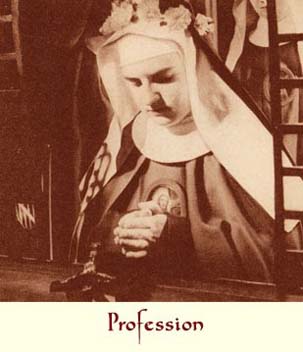In the world : Caroline-Marguerite-Elisabeth
Van Rijckevorsel [1]
Van Rijckevorsel [1]
It was under the protection of our father, Saint Alphonsus, that is to say, on the anniversary day of his blessed death, that our future Redemptoristine came into the world. Miss Caroline Marguerite Elisabeth Van Rijckevorsel was born at Rotterdam on 1st August 1821. Her father, Baron James-Joseph Van Rijckevorsel, and her mother, Mrs. Henriette Petronilla Van Oosthuisen, were good and fervent Catholics, who prided themselves on practising their religion in a Protestant country. Their union was richly blessed by the birth of seven sons and little Caroline. Their mother was snatched away rather quickly by death, but Baron Van Rijckevorsel had had a daughter from his first marriage who was like a second mother to her brothers and sister. And also, our good Sister Marie-Marguerite told us later on what grief she had and how much she wept when a servant girl told her one day that Miss Louise was not her real sister. Their affections prevailed, however, and when, later on, Louise had married Mr. Gustave Dommers van Polderveld, and Caroline had become the humble Sister Marie-Marguerite of the Sacred Heart of Jesus, their friendship always remained both strong and affectionate.
Young Caroline had her education at the Sacred Heart of Jette, and upon her return to the paternal home, she saw herself surrounded by the affection of all her brothers. She said later on: “They all came to consult me.” This affection for their little sister never decreased, and for her part, she was always keenly interested in the welfare of her brothers. But young Caroline had heard the call of the Lord, and stimulated perhaps by the example of her brother John Rijckevorsel, who became a Redemptorist, she directed her choice towards the convent of the Redemptoristines founded recently at Bruges by the Reverend Mother Marie-Alphonsus of the Will of God.
Baron Van Rijckevorsel was too good a Catholic to oppose the pious desire of his cherished daughter. At the age of 21, she entered the Convent of Bruges on 10th April 1842. Her dowry, which was considerable, came at the right time to support this newly established house. After an exemplary educandate and novitiate, she received the holy habit of the Order on 26th July 1843, and was called Sister Marie-Marguerite of the Sacred heart of Jesus. Her profession took place on 12th August 1844. She made herself very useful in a community which was being formed. She was pleased to tell us that, on leaving the novitiate, she was employed as an aide in the sacristy. The Sister who was in charge had such a great love of poverty that she ended up by wanting the impossible. So one day she expected her aide to patch up a tin bucket which was used to hold the holy water and in which the salt had worn holes in the bottom. The young Sister accepted the task (I think that it was a test, she told us); but how was she to repair all the holes? She did the best she could, but she could not do it as well as the Sister Sacristan wanted.
In 1858, when the foundation at Velp was decided, Baron Van Rijckevorsel asked Mons the Archbishop Zwijsen to send his daughter there. The Reverend Mother Marie-Philomene, the Superior at Bruges, acquiesced to the wishes of the Prelate and Baron Van Rijckevorsel. The little house in the country popularly known as “Bronkhorst Castle” was bought in his name. His great fortune had been employed at Bruges in the construction of the church and the convent. On 19th June 1858, young Sister Marie-Marguerite left with the Sisters for the new foundation, where she was to fulfil the task of Vicar. After sixteen years of absence, she was once again on the road to her own country, so generously sacrificed to obey the call of the divine Redeemer.
This nascent community was to give her the occasion to disclose many virtues, the love she had for her holy vocation and the devotion of which she was capable. If, at Bruges, a Sister, without wishing it perhaps, had made her exercise holy poverty, here, in this nascent foundation, the practice of it was a daily event. But the Sister never made any remark complaining of it. On the contrary, enjoying good health, she was content with everything and knew how to enliven with a good word the meagre festive meals of the poor community.
The dear Mother Vicar had an active and courageous character and was the soul of everything. As the only Dutch woman in the monastery, she was a special help to her Superior in the affairs of outside and with correspondence. They did not even possess the holy Rule in Dutch. The dear Mother Vicar set herself to the work and made the desired translation, and so they could then have it read out in the refectory, and at the prescribed times for the converse Sisters, who did not understand all the readings in French. Inside the monastery, she was the organist and it was her duty to support the recitation of the Divine Office.
When it was a matter of giving the holy habit to the first novice, it was Mother Vicar again who was given the task of making the costume. However, I believe she went to ask for help from her companions, but as none of them had been employed at this task at Bruges, she had to try to do it by herself. And Mother Vicar succeeded, so she was named as the first Vestiarian. This was a good occasion for her to practise holy poverty for herself, and she went on doing so the rest of her life, as all the clothes that this dear Mother wore were poor and patched.
Charged with supervision of the garden, she knew how to make herself loved and respected by the good workmen. Once it happened after the change of offices, when she was no longer the Vicar, she begged her companion to tell the gardener not to go on giving her the title. This good man, who understood nothing of the religious formalities, replied in a rather discontented tone: “When things are going well, why change them?” He did his best, but all too often habit got the upper hand.
Named Housekeeper, she had once again to be busy with service persons. She could then be seen accompanying the workmen with her bell in her hand, bringing a ladder or other tools, in order to spare them the trouble of having to find them, and to prevent the Sisters having to meet them. She was truly Sister Martha through her devotion. At different times, the water levels were very high at Velp, and the convent would then experience great damage. The cellars would be submerged and all the provisions had to be brought out of them. Our good Sister Marie-Marguerite was always there directing the removals, and either by day or by night, she would bring help wherever it was necessary. Inspired by a great devotion for Saint Joseph, as Housekeeper, she entrusted her poor work-box to him (it was a former glove-box). On the inside a beautiful picture of the holy Patriarch was glued. On 19th March, the day of his feast was always celebrated in the Robing Room, which also served as her cell (this was at the beginning of the foundation). After Compline, which was said at three o’clock, we went past there on our way to choir. The door of the Robing Room was open and anyone could enter. Our dear Sister had improvised a decoration for her privileged Saint. The little wooden statue was surrounded with flowers and lights, the vases were of cardboard, bobbins served as candlesticks, and also, and this made this meeting place more dear to us still, the ends of little candles or tapers which served to light up the feast, were ordinarily (with the permission of the Reverend Mother Superior), adroitly taken by the good Sister from the Sacristan. She, at this time, was her former first Sacristan Mistress from Bruges, known for her extreme parsimony. You could not easily obtain even a candle end from her, but Sister Marie-Marguerite knew how to help herself without her noticing. When everyone was gathered in the Robing Room, they then began to pray to the good Saint Joseph, and this heavenly provider, for his part, made sure that, in spite of their great poverty, there was no lack of anything necessary.
The good God brought some pleasant surprises to the courageous and fervent Sister Marie-Marguerite from her noble family. Right at the beginning, when the Sisters arrived at Velp, Mrs. Louise Dommers came to see her dear Caroline and brought her some beautiful camellia plants. These plants were old acquaintances, and she received them with joy. She had nursed these plants after her return from the boarding school, and when she left for the convent, Louise had been put in charge, and now, by a delicate attention, they had come back to their former mistress, and for a long time to come the beautiful flowers were the ornaments of our little chapel.
Later on, Baron Van Rijckevorsel made a present to the community of a beautiful white chasuble, and a beautiful antependium (altar frontal) for the altar, matched to the chasuble. One day Rev. Father John came to say the Holy Mass, and the family attended. The pious Baron considered it an honour to be the servant of his son, the priest, and it was a great consolation for our dear Sister Marie-Marguerite. A short time later, the revered old man went to heaven to receive the reward of his good works.
One year (it was in 1863) Rev. Father John, who had been doing all he could to help the community, wrote to his sister: “At about Christmas, you will have a visit from one of our greatest benefactors. He wants to come to Velp, but he wants you to receive him in all simplicity.” Good news, but somewhat embarrassing, as they always wanted to have something to offer visitors arriving unexpectedly. A visit to Velp in the middle of winter, with nothing done in advance, would not be very pleasant. Out of prudence, Reverend Mother warned the Sister Housekeeper so that she would not be taken unawares. While they were waiting, the imagination of the Sisters, and especially that of our dear Sister Marie-Marguerite, had full play, and in more than one recreation, it was the subject of a very heated conversation. Every time the bell rang at some unexpected hour, it was a warning to their curiosity held in suspense.
Finally, on 27th December, during the evening recreation, the bell rang at the turn. A little box had just arrived. The Reverend Mother had it brought into the community room and they were able to open it. All the Sisters were there waiting, and finally their curiosity was satisfied… But what a surprise! They saw a charming Child Jesus appear (from Munich) lying on straw. The joy of all the Sisters was not to be described. The Converse Sisters were called, and in the blink of an eye, everyone was kneeling around the divine little Redeemer, who was indeed the great Benefactor promised. We gratefully remembered the promise made by Rev. Father John and the delicacy with which he accompanied his beautiful gift. The pretty statue is still well preserved and it decorates the convent chapel.
With the separation from Bruges (in temporal matters) decided by Monsignor in 1865, the community was reduced to its own resources, always insufficient to provide for the needs of its members. But Providence looked after them, and the family of Sister Marie-Marguerite came to our aid by providing coal and provisions. This goodness of her family filled the good Sister with courage and inspired her fervour in the service of the good Master and her devotion to her dear community.
On the feast of Saint Nicholas, which is very popular and general in Holland, one of her sisters-in-law always sent her a box filled with cakes. Her whole pleasure was in being able to send the box on with a little surprise for her little nephews and nieces. With what joy and gratitude did she receive the little objects that the Sisters, with the permission of Reverend Mother, offered her on this occasion! It could be said that she was receiving real treasures, and so our good Reverend Mother made sure that the box was well supplied, and that all these dear people had good reason to praise good Saint Nicholas of Velp.
The 12th August 1869 was also a good day for our dear Sister. She celebrated the jubilee of her twenty five years of profession. Her brothers and her sister made it their duty to come and congratulate their Caroline and share in her happiness. She received many lovely presents for the chapel, and the day was a true family feast for everyone. This was the last time that she saw her family reunited, for soon death took away the eldest of her brothers, Baron Pierre Van Rijckevorsel.
Sister Marie-Marguerite loved and valued her holy vocation. Faithful to regular observance, in spite of her numerous occupations of every kind, she was always present at the Divine Office in choir and at the community acts. Her piety was inspired by a lively faith. She had very little time available for her private devotions, and so, whenever she had a moment of leisure, for example, in the five minutes before the Office or when she was the auditrix, she could be seen holding her little manual, a souvenir from her boarding school, and reciting one or another little office of the Sacred Heart or the Immaculate Conception. After her death, they found a very devout picture of the Sacred Heart in this little book, together with one of Saint Joseph with little Jesus. She was always one of the Sisters who, on carnival days, spent the night of Holy Thursday in prayer, or on other occasions when the Superior gave her special permission.
As she was brought up at Jette, devotion to the Sacred Heart of Jesus was dear to her, and her joy was great when they decided that our future chapel would be consecrated to her. She displayed all her zeal in contributing to the costs of the building. As permission had been given to place some pictures to this effect, she set herself to paint some pictures and have them placed by her acquaintances and her family. Great was her joy when the chapel was built and Mons. Godschalk, the Bishop of Bois-le-Duc, came to bless the bells. One of these bells was given by Mr. Auguste Van Rijckevorsel and Madame Dowager of Thomas Van Rijckevorsel, born Baroness Van Landschode. Her brother and sister-in-law were her Godfather and Godmother. Her devotion to the Blessed Virgin was that of all the children of Saint Alphonsus. She loved this good Mother with a filial love. From her brother, Mr. Cornil Van Rijckevorsel, she received a beautiful Calvary with the Mother of sorrows, and this was placed on the altar in the first little chapel. At her jubilee, she was given a lovely Immaculate Virgin and another Calvary group.
In the midst of these multiple occupations, our good Sister Marie-Marguerite needed a little rest of the spirit, and besides, recreation was a common act. One day, the Reverend Capuchin Fathers ordered some of our work for their sacristy – some chasubles and antependiums, which had to be made of tapestry in part. Great was the joy of our good Sister – it was providential! She wished to help with the embroidery. For a long time she had had to say farewell to these works that she had loved so much formerly. And now she could be seen at work, even during recreation (where we are allowed to be busy with some kind of manual work), but counting the points and having recreation did not go together, and our good Sister Marie-Marguerite was obliged to undo the little bit that she had been able to do in recreation, during the time of silence. This amused us, but our innocent humour did not disconcert her.
She was hard on herself and did not spare herself in anything, but if, with her good health, she could struggle against fatigue, she was nonetheless charitable towards the sick. Sometimes, in recreation, she told us laughing: “Father would say, ‘My children have no nerves.’” However, on occasions, it was easy to see that she had not been deprived of them, but her strong nature and manly virtue were able to overcome them.
Later on, when the community was beginning to be formed, she was always ready to exercise the young Sisters in the chanting of the Divine Office or help the young organists in their difficulties. Once it happened that one of them, finding herself at the organ, was stumped by a difficult passage. She wanted to have recourse to her charitable mistress, but where to find her? The summoning of the Sisters by the bell was not yet organised… Finally, she saw Sister Marie-Marguerite in the garden busy digging, in her full gardener’s costume, big boots, and big grey apron. As soon as the young Sister begged her to come and help her, she laughed and left her laborious work and came and sat down at the organ.
Another Sister, made Housekeeper, often had recourse to her experience, and Sister Marie-Marguerite always helped her with the same charity in her difficulties, and with a word of encouragement to revive her confidence in good Saint Joseph and have abandonment to the divine Providence.
Very often, when Reverend Mother Marie-Cherubine was preoccupied with the future of the nascent community, and “built castles in Spain” as a diversion away from some rather discouraging thoughts about the slow prosperity of the convent, our good Sister Marie-Marguerite told her: “I don’t think I’ll die before the chapel is built!” It was a dream, it seems, the realisation of which would probably not be seen soon.
But, in 1879 and 1880, in a most providential way, the chapel was built. Did our good Sister recall her prediction? I do not know, but at about this same time, her health declined. At first she resisted the illness. Having in fact never been ill before, she did not know how to care for herself or let others care for her. One day, she gave great concerns to the Sister Infirmarian. This Sister had given her a bottle and told her she had to take a spoonful according to the doctor’s prescription, but Sister Marie-Marguerite had the thought that if she drank it too quickly, it would not last very long – it would be far too quick. As she thought, so she did. Later on, the Infirmarian came up to her and recommended to her patient to be exact in taking her medicine. “Oh, it’s finished,” replied the Sister, “here’s the empty bottle.” One can imagine the shock and anxiety of good Sister Marie-Therese. The invalid did not move. The Infirmarian prayed and the good God permitted that this great imprudence did not lead to a harmful outcome, but the Infirmarian now knew who she was dealing with and took appropriate measures in consequence. The dear invalid was wasting away before her eyes, but was still trying to keep going, especially to the community acts. Her swollen feet would not longer fit into her shoes, so Reverend Mother bought a pair of slippers for her. One day she arrived at recreation arm in arm with a Sister who was leading her, walking with heavy steps and telling everyone who wanted to hear her: “Our Mother has given me a pair of slippers.” She still wanted to amuse the Sisters.
At the jubilee feast of the foundation of the convent and the twenty fifth anniversary of the Superiority of Reverend Mother Marie-Cherubine, on 19th July 1883, our dear Sister Marie-Marguerite, already very ill, went to the refectory again, but could only drink a glass of water. Her stomach, eaten away by cancer, was refusing all nourishment and she was suffering from hunger. At table she sat down in her place in order to participate in the common joy, but on different occasions she was obliged to leave the room. Shortly afterwards she was forced to keep to her cell, and as the cold weather came early, they got her to accept a heated room. At the beginning of the month of October, she had a severe crisis that terrified the Infirmarians, and the last sacraments were administered to her. However, her illness settled down and the community began its great retreat. In the first few days, the Very Reverend Father G. Wulfingh came to confess the invalids. At the request of the Infirmarian he also went to Sister Marie-Marguerite. She had a long conversation with the good Father, who was to come back the next day and bring her Holy Communion. The Sister charged with the care of the sick came at about 8:30 and said a few words to her about communion the next day. Sister Marie-Marguerite seemed comfortable and said to her: “I am going to sleep now.” The Sister went to the other end of the room to recite her Office. Shortly afterwards, she could hear that the dear invalid was breathing quite heavily. She went up to her. A great change had in fact happened in her state. The Infirmarians came running. They hastened to get the Reverend Father who was still praying in the chapel. When the Touriere came to tell him that Sister Marie-Marguerite was dying, he could not believe her. “But she was speaking so well to me just this afternoon,” he said. Then he went to see the dear invalid and could only give her a final absolution, and then recite the De Profundis. The good Jesus had come to find his faithful and fervent Spouse. This was on 18th October 1883, at about nine o’clock in the evening.
Young Caroline had her education at the Sacred Heart of Jette, and upon her return to the paternal home, she saw herself surrounded by the affection of all her brothers. She said later on: “They all came to consult me.” This affection for their little sister never decreased, and for her part, she was always keenly interested in the welfare of her brothers. But young Caroline had heard the call of the Lord, and stimulated perhaps by the example of her brother John Rijckevorsel, who became a Redemptorist, she directed her choice towards the convent of the Redemptoristines founded recently at Bruges by the Reverend Mother Marie-Alphonsus of the Will of God.
Baron Van Rijckevorsel was too good a Catholic to oppose the pious desire of his cherished daughter. At the age of 21, she entered the Convent of Bruges on 10th April 1842. Her dowry, which was considerable, came at the right time to support this newly established house. After an exemplary educandate and novitiate, she received the holy habit of the Order on 26th July 1843, and was called Sister Marie-Marguerite of the Sacred heart of Jesus. Her profession took place on 12th August 1844. She made herself very useful in a community which was being formed. She was pleased to tell us that, on leaving the novitiate, she was employed as an aide in the sacristy. The Sister who was in charge had such a great love of poverty that she ended up by wanting the impossible. So one day she expected her aide to patch up a tin bucket which was used to hold the holy water and in which the salt had worn holes in the bottom. The young Sister accepted the task (I think that it was a test, she told us); but how was she to repair all the holes? She did the best she could, but she could not do it as well as the Sister Sacristan wanted.
In 1858, when the foundation at Velp was decided, Baron Van Rijckevorsel asked Mons the Archbishop Zwijsen to send his daughter there. The Reverend Mother Marie-Philomene, the Superior at Bruges, acquiesced to the wishes of the Prelate and Baron Van Rijckevorsel. The little house in the country popularly known as “Bronkhorst Castle” was bought in his name. His great fortune had been employed at Bruges in the construction of the church and the convent. On 19th June 1858, young Sister Marie-Marguerite left with the Sisters for the new foundation, where she was to fulfil the task of Vicar. After sixteen years of absence, she was once again on the road to her own country, so generously sacrificed to obey the call of the divine Redeemer.
This nascent community was to give her the occasion to disclose many virtues, the love she had for her holy vocation and the devotion of which she was capable. If, at Bruges, a Sister, without wishing it perhaps, had made her exercise holy poverty, here, in this nascent foundation, the practice of it was a daily event. But the Sister never made any remark complaining of it. On the contrary, enjoying good health, she was content with everything and knew how to enliven with a good word the meagre festive meals of the poor community.
The dear Mother Vicar had an active and courageous character and was the soul of everything. As the only Dutch woman in the monastery, she was a special help to her Superior in the affairs of outside and with correspondence. They did not even possess the holy Rule in Dutch. The dear Mother Vicar set herself to the work and made the desired translation, and so they could then have it read out in the refectory, and at the prescribed times for the converse Sisters, who did not understand all the readings in French. Inside the monastery, she was the organist and it was her duty to support the recitation of the Divine Office.
When it was a matter of giving the holy habit to the first novice, it was Mother Vicar again who was given the task of making the costume. However, I believe she went to ask for help from her companions, but as none of them had been employed at this task at Bruges, she had to try to do it by herself. And Mother Vicar succeeded, so she was named as the first Vestiarian. This was a good occasion for her to practise holy poverty for herself, and she went on doing so the rest of her life, as all the clothes that this dear Mother wore were poor and patched.
Charged with supervision of the garden, she knew how to make herself loved and respected by the good workmen. Once it happened after the change of offices, when she was no longer the Vicar, she begged her companion to tell the gardener not to go on giving her the title. This good man, who understood nothing of the religious formalities, replied in a rather discontented tone: “When things are going well, why change them?” He did his best, but all too often habit got the upper hand.
Named Housekeeper, she had once again to be busy with service persons. She could then be seen accompanying the workmen with her bell in her hand, bringing a ladder or other tools, in order to spare them the trouble of having to find them, and to prevent the Sisters having to meet them. She was truly Sister Martha through her devotion. At different times, the water levels were very high at Velp, and the convent would then experience great damage. The cellars would be submerged and all the provisions had to be brought out of them. Our good Sister Marie-Marguerite was always there directing the removals, and either by day or by night, she would bring help wherever it was necessary. Inspired by a great devotion for Saint Joseph, as Housekeeper, she entrusted her poor work-box to him (it was a former glove-box). On the inside a beautiful picture of the holy Patriarch was glued. On 19th March, the day of his feast was always celebrated in the Robing Room, which also served as her cell (this was at the beginning of the foundation). After Compline, which was said at three o’clock, we went past there on our way to choir. The door of the Robing Room was open and anyone could enter. Our dear Sister had improvised a decoration for her privileged Saint. The little wooden statue was surrounded with flowers and lights, the vases were of cardboard, bobbins served as candlesticks, and also, and this made this meeting place more dear to us still, the ends of little candles or tapers which served to light up the feast, were ordinarily (with the permission of the Reverend Mother Superior), adroitly taken by the good Sister from the Sacristan. She, at this time, was her former first Sacristan Mistress from Bruges, known for her extreme parsimony. You could not easily obtain even a candle end from her, but Sister Marie-Marguerite knew how to help herself without her noticing. When everyone was gathered in the Robing Room, they then began to pray to the good Saint Joseph, and this heavenly provider, for his part, made sure that, in spite of their great poverty, there was no lack of anything necessary.
The good God brought some pleasant surprises to the courageous and fervent Sister Marie-Marguerite from her noble family. Right at the beginning, when the Sisters arrived at Velp, Mrs. Louise Dommers came to see her dear Caroline and brought her some beautiful camellia plants. These plants were old acquaintances, and she received them with joy. She had nursed these plants after her return from the boarding school, and when she left for the convent, Louise had been put in charge, and now, by a delicate attention, they had come back to their former mistress, and for a long time to come the beautiful flowers were the ornaments of our little chapel.
Later on, Baron Van Rijckevorsel made a present to the community of a beautiful white chasuble, and a beautiful antependium (altar frontal) for the altar, matched to the chasuble. One day Rev. Father John came to say the Holy Mass, and the family attended. The pious Baron considered it an honour to be the servant of his son, the priest, and it was a great consolation for our dear Sister Marie-Marguerite. A short time later, the revered old man went to heaven to receive the reward of his good works.
One year (it was in 1863) Rev. Father John, who had been doing all he could to help the community, wrote to his sister: “At about Christmas, you will have a visit from one of our greatest benefactors. He wants to come to Velp, but he wants you to receive him in all simplicity.” Good news, but somewhat embarrassing, as they always wanted to have something to offer visitors arriving unexpectedly. A visit to Velp in the middle of winter, with nothing done in advance, would not be very pleasant. Out of prudence, Reverend Mother warned the Sister Housekeeper so that she would not be taken unawares. While they were waiting, the imagination of the Sisters, and especially that of our dear Sister Marie-Marguerite, had full play, and in more than one recreation, it was the subject of a very heated conversation. Every time the bell rang at some unexpected hour, it was a warning to their curiosity held in suspense.
Finally, on 27th December, during the evening recreation, the bell rang at the turn. A little box had just arrived. The Reverend Mother had it brought into the community room and they were able to open it. All the Sisters were there waiting, and finally their curiosity was satisfied… But what a surprise! They saw a charming Child Jesus appear (from Munich) lying on straw. The joy of all the Sisters was not to be described. The Converse Sisters were called, and in the blink of an eye, everyone was kneeling around the divine little Redeemer, who was indeed the great Benefactor promised. We gratefully remembered the promise made by Rev. Father John and the delicacy with which he accompanied his beautiful gift. The pretty statue is still well preserved and it decorates the convent chapel.
With the separation from Bruges (in temporal matters) decided by Monsignor in 1865, the community was reduced to its own resources, always insufficient to provide for the needs of its members. But Providence looked after them, and the family of Sister Marie-Marguerite came to our aid by providing coal and provisions. This goodness of her family filled the good Sister with courage and inspired her fervour in the service of the good Master and her devotion to her dear community.
On the feast of Saint Nicholas, which is very popular and general in Holland, one of her sisters-in-law always sent her a box filled with cakes. Her whole pleasure was in being able to send the box on with a little surprise for her little nephews and nieces. With what joy and gratitude did she receive the little objects that the Sisters, with the permission of Reverend Mother, offered her on this occasion! It could be said that she was receiving real treasures, and so our good Reverend Mother made sure that the box was well supplied, and that all these dear people had good reason to praise good Saint Nicholas of Velp.
The 12th August 1869 was also a good day for our dear Sister. She celebrated the jubilee of her twenty five years of profession. Her brothers and her sister made it their duty to come and congratulate their Caroline and share in her happiness. She received many lovely presents for the chapel, and the day was a true family feast for everyone. This was the last time that she saw her family reunited, for soon death took away the eldest of her brothers, Baron Pierre Van Rijckevorsel.
Sister Marie-Marguerite loved and valued her holy vocation. Faithful to regular observance, in spite of her numerous occupations of every kind, she was always present at the Divine Office in choir and at the community acts. Her piety was inspired by a lively faith. She had very little time available for her private devotions, and so, whenever she had a moment of leisure, for example, in the five minutes before the Office or when she was the auditrix, she could be seen holding her little manual, a souvenir from her boarding school, and reciting one or another little office of the Sacred Heart or the Immaculate Conception. After her death, they found a very devout picture of the Sacred Heart in this little book, together with one of Saint Joseph with little Jesus. She was always one of the Sisters who, on carnival days, spent the night of Holy Thursday in prayer, or on other occasions when the Superior gave her special permission.
As she was brought up at Jette, devotion to the Sacred Heart of Jesus was dear to her, and her joy was great when they decided that our future chapel would be consecrated to her. She displayed all her zeal in contributing to the costs of the building. As permission had been given to place some pictures to this effect, she set herself to paint some pictures and have them placed by her acquaintances and her family. Great was her joy when the chapel was built and Mons. Godschalk, the Bishop of Bois-le-Duc, came to bless the bells. One of these bells was given by Mr. Auguste Van Rijckevorsel and Madame Dowager of Thomas Van Rijckevorsel, born Baroness Van Landschode. Her brother and sister-in-law were her Godfather and Godmother. Her devotion to the Blessed Virgin was that of all the children of Saint Alphonsus. She loved this good Mother with a filial love. From her brother, Mr. Cornil Van Rijckevorsel, she received a beautiful Calvary with the Mother of sorrows, and this was placed on the altar in the first little chapel. At her jubilee, she was given a lovely Immaculate Virgin and another Calvary group.
In the midst of these multiple occupations, our good Sister Marie-Marguerite needed a little rest of the spirit, and besides, recreation was a common act. One day, the Reverend Capuchin Fathers ordered some of our work for their sacristy – some chasubles and antependiums, which had to be made of tapestry in part. Great was the joy of our good Sister – it was providential! She wished to help with the embroidery. For a long time she had had to say farewell to these works that she had loved so much formerly. And now she could be seen at work, even during recreation (where we are allowed to be busy with some kind of manual work), but counting the points and having recreation did not go together, and our good Sister Marie-Marguerite was obliged to undo the little bit that she had been able to do in recreation, during the time of silence. This amused us, but our innocent humour did not disconcert her.
She was hard on herself and did not spare herself in anything, but if, with her good health, she could struggle against fatigue, she was nonetheless charitable towards the sick. Sometimes, in recreation, she told us laughing: “Father would say, ‘My children have no nerves.’” However, on occasions, it was easy to see that she had not been deprived of them, but her strong nature and manly virtue were able to overcome them.
Later on, when the community was beginning to be formed, she was always ready to exercise the young Sisters in the chanting of the Divine Office or help the young organists in their difficulties. Once it happened that one of them, finding herself at the organ, was stumped by a difficult passage. She wanted to have recourse to her charitable mistress, but where to find her? The summoning of the Sisters by the bell was not yet organised… Finally, she saw Sister Marie-Marguerite in the garden busy digging, in her full gardener’s costume, big boots, and big grey apron. As soon as the young Sister begged her to come and help her, she laughed and left her laborious work and came and sat down at the organ.
Another Sister, made Housekeeper, often had recourse to her experience, and Sister Marie-Marguerite always helped her with the same charity in her difficulties, and with a word of encouragement to revive her confidence in good Saint Joseph and have abandonment to the divine Providence.
Very often, when Reverend Mother Marie-Cherubine was preoccupied with the future of the nascent community, and “built castles in Spain” as a diversion away from some rather discouraging thoughts about the slow prosperity of the convent, our good Sister Marie-Marguerite told her: “I don’t think I’ll die before the chapel is built!” It was a dream, it seems, the realisation of which would probably not be seen soon.
But, in 1879 and 1880, in a most providential way, the chapel was built. Did our good Sister recall her prediction? I do not know, but at about this same time, her health declined. At first she resisted the illness. Having in fact never been ill before, she did not know how to care for herself or let others care for her. One day, she gave great concerns to the Sister Infirmarian. This Sister had given her a bottle and told her she had to take a spoonful according to the doctor’s prescription, but Sister Marie-Marguerite had the thought that if she drank it too quickly, it would not last very long – it would be far too quick. As she thought, so she did. Later on, the Infirmarian came up to her and recommended to her patient to be exact in taking her medicine. “Oh, it’s finished,” replied the Sister, “here’s the empty bottle.” One can imagine the shock and anxiety of good Sister Marie-Therese. The invalid did not move. The Infirmarian prayed and the good God permitted that this great imprudence did not lead to a harmful outcome, but the Infirmarian now knew who she was dealing with and took appropriate measures in consequence. The dear invalid was wasting away before her eyes, but was still trying to keep going, especially to the community acts. Her swollen feet would not longer fit into her shoes, so Reverend Mother bought a pair of slippers for her. One day she arrived at recreation arm in arm with a Sister who was leading her, walking with heavy steps and telling everyone who wanted to hear her: “Our Mother has given me a pair of slippers.” She still wanted to amuse the Sisters.
At the jubilee feast of the foundation of the convent and the twenty fifth anniversary of the Superiority of Reverend Mother Marie-Cherubine, on 19th July 1883, our dear Sister Marie-Marguerite, already very ill, went to the refectory again, but could only drink a glass of water. Her stomach, eaten away by cancer, was refusing all nourishment and she was suffering from hunger. At table she sat down in her place in order to participate in the common joy, but on different occasions she was obliged to leave the room. Shortly afterwards she was forced to keep to her cell, and as the cold weather came early, they got her to accept a heated room. At the beginning of the month of October, she had a severe crisis that terrified the Infirmarians, and the last sacraments were administered to her. However, her illness settled down and the community began its great retreat. In the first few days, the Very Reverend Father G. Wulfingh came to confess the invalids. At the request of the Infirmarian he also went to Sister Marie-Marguerite. She had a long conversation with the good Father, who was to come back the next day and bring her Holy Communion. The Sister charged with the care of the sick came at about 8:30 and said a few words to her about communion the next day. Sister Marie-Marguerite seemed comfortable and said to her: “I am going to sleep now.” The Sister went to the other end of the room to recite her Office. Shortly afterwards, she could hear that the dear invalid was breathing quite heavily. She went up to her. A great change had in fact happened in her state. The Infirmarians came running. They hastened to get the Reverend Father who was still praying in the chapel. When the Touriere came to tell him that Sister Marie-Marguerite was dying, he could not believe her. “But she was speaking so well to me just this afternoon,” he said. Then he went to see the dear invalid and could only give her a final absolution, and then recite the De Profundis. The good Jesus had come to find his faithful and fervent Spouse. This was on 18th October 1883, at about nine o’clock in the evening.
Footnotes
[1] From the Monastery Chronicles.
This necrology is translated from Fleurs de l'Institut des Rédemptoristines by Mr John R. Bradbury. The copyright of this translation is the property of the Redemptoristine Nuns of Maitland, Australia. The integral version of the translated book will be posted here as the necrologies appear.
